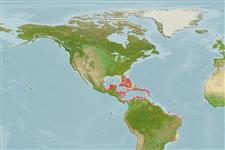Actinopterygii (ray-finned fishes) >
Perciformes (Perch-likes) >
Opistognathidae (Jawfishes)
Etymology: Opistognathus: Greek, opisthe = behind + Greek, gnathos = jaw (Ref. 45335).
Environment / Climate / Range
Ecology
Marine; reef-associated; depth range 1 - 12 m (Ref. 9710). Tropical, preferred ?
Western Atlantic: southern Florida, USA and Bahamas to northern South America.
Size / Weight / Age
Maturity: Lm ? range ? - ? cm
Max length : 14.0 cm TL male/unsexed; (Ref. 6937)
Short description
Morphology | Morphometrics
Dorsal
spines
(total): 11;
Dorsal
soft rays
(total): 14-15;
Anal
spines: 3;
Anal
soft rays: 13 - 14. The dark spot (deep greenish blue in life) of the dorsal fin usually found between the 2nd and 4th or 5th dorsal spines; body densely mottled with dark brown and flecked with blackish; caudal fin and posterior part of dorsal fin are yellow with rows of small blackish spots (Ref. 13442).
Inhabits rock and sand bottoms or the eroding edges of weed beds. Egg mass incubated in mouth of males (Ref. 5521).
Life cycle and mating behavior
Maturity | Reproduction | Spawning | Eggs | Fecundity | Larvae
Are mouthbrooders (Ref. 39363).
Böhlke, J.E. and C.C.G. Chaplin, 1993. Fishes of the Bahamas and adjacent tropical waters. 2nd edition. University of Texas Press, Austin. (Ref. 5521)
IUCN Red List Status (Ref. 115185)
CITES (Ref. 94142)
Not Evaluated
Threat to humans
Harmless
Human uses
Aquarium: commercial
More information
Age/SizeGrowthLength-weightLength-lengthLength-frequenciesMorphometricsMorphologyLarvaeLarval dynamicsRecruitmentAbundance
ReferencesAquacultureAquaculture profileStrainsGeneticsAllele frequenciesHeritabilityDiseasesProcessingMass conversion
Tools
Special reports
Download XML
Internet sources
